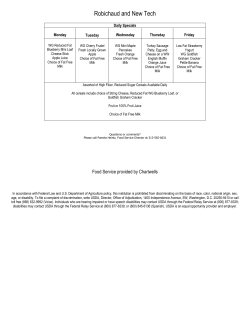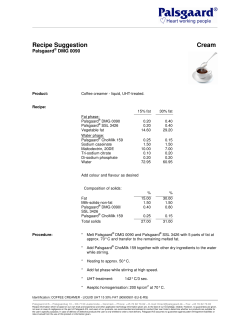
Fat and Cholesterol Containing Intracranial Lesions Pat Farley, MD
Fat and Cholesterol
Containing Intracranial
Lesions
Pat Farley, MD
Neuroradiology Division, UNC
Objectives
• To name fat containing lesions of the
brain.
• Give differentiators of these lesions.
• Recognize associations and complications
of these lesions.
• Recognize that dermoid and epidermoid
do not look alike, just sound alike.
Dermoid Cyst
• Unilocular cyst with thick walls of connective
tissue
• Rare
– <0.5 % of intracranial tumors
• Clinical Issues
– Uncomplicated Dermoids:
• Headache (30%)
• Seizure (30%)
Dermoids, Complications
• Rupture
– This can cause a chemical meningitis as the fat
droplets spread within the subarachnoid space with
resultant inflammatory changes.
– Larger lesions are associated with higher risk of
rupture.
• Transformation
– Rarely can transform in to a malignant squamous cell
cancer.
• Dermal sinus
– Can lead to infection.
Dermoids, Imaging Appearance
• Well-circumscribed lipid containing masses
• Location
–
–
–
–
Most often in sellar/parasellar/frontonasal region
Posterior fossa; midline vermis & 4th ventricle
May be intraventricular in lateral, 3rd, or 4th ventricles
May also be located in spine and orbits
• Ruptured Dermoid
– Subarachnoid/intraventricular spread of fat contents
• Size
– Variable
Dermoids, CT Appearance
• Non Contrast CT
– Classic
•
•
•
•
Round/lobulated, well-delineated, cystic mass
Fat hypodensity
20% contain capsular calcifications
Rupture, droplets of fat disseminate in cisterns, may cause fat-fluid
level within ventricles
– Atypical
• "dense" dermoid: Hyper attenuating on CT
• Skull/scalp dermoid expands diploic space
• Frontonasal - Bifid crista galli, large foramen cecum with
possible sinus tract
• Post Contrast - No enhancement
Dermoids, MRI
• T1 and T2:
– Hyperintense mass on T1WI. Heterogeneous
signal on T2.
– Chemical shift artifact in frequency encoding
direction
– Ruptured Dermoid
• Droplets very hyperintense on T1WI
– Fat suppression sequence confirms
– Fat-fluid level in cyst, ventricles common
– "dense" dermoid also hyperintense on T1WI
Dermoid (large arrow, left) and fat droplets in SAS
(arrows, right) are clearly seen.
Dermoids, MRI with Contrast
• Unruptured
– No enhancement
• Ruptured
– Can have intense meningeal enhancement
secondary to chemical meningitis.
• MR Spectroscopy
– Strong and broad resonances from mobile
lipids at 0.9 and 1.3 ppm
Dermoids, Angiography/MRA
• Vasospasm may be present with rupture
• Vessels encased by dermoid have an
increased risk of rupture.
Dermoids, Prognosis/Therapy
• Complete microsurgical excision
– Residual capsule may lead to recurrence
– Rarely surgical remnants may degenerate in to
squamous cell cancer
• Subarachnoid dissemination of contents may
occur during operative/postoperative course
– Cause aseptic meningitis or other complications
(hydrocephalus, seizures, CN deficits)
– Disseminated fat particles can remain silent without
neurologic changes
Dermoid vs. Epidermoid
• Epidermoid = congenital inclusion cyst
• Usual appearance is similar to CSF
– Appearance is not identical to CSF however
• FLAIR usually does not completely suppress
• T1/T2 may be slightly off, CISS/FIESTA show internal
structures
• Diffusion restriction is key
• Can see internal structures on CISS imaging
• Mass interdigitates in cisterns, and encases
nerves and vessels.
• Most common differential for epidermoid is
arachnoid cyst.
Epidermoid in left CPA cistern is similar to CSF but
not exactly like it. Note internal structures.
DWI shows high signal
from this epidermoid in the
left CPA cistern.
Epidermoid that could be confused
with Dermoid
• Rare variant
– Uncommonly hyperintense to brain ("white
epidermoid") due to high triglycerides &
unsaturated fatty acids
Epidermoid vs. Arachnoid Cyst
• Diffusion is key
• Epidermoid is restricted
• Arachnoid cyst is not
• Also epidermoids insinuate into adjacent
tissues, arachnoid cysts tend to displace
them.
Left middle cranial fossa arachnoid cyst shows no
enhancement and no restricted diffusion on ADC map (right).
Craniopharyngioma
• Benign epithelial tumor derived from
Rathke’s pouch epithelium
• Two Types:
– Adamantinomatous type (classic)
• hyperintense cyst and heterogeneous nodule
• More common in children (first age peak)
– Papillary type (more rare)
• isointense solid component
• More common in adults (second age peak)
Imaging of Adamantinomatous
Craniopharyngioma
• CT: Partially calcified, partially solid, cystic
suprasellar mass
• MR :
– T1 without Gd
• High signal intensity suprasellar mass on precontrast T1WI (protein, cholesterol, blood
products in fluid)
– T1 with Gd:
• Solid portions enhance heterogeneously, cyst
walls enhance strongly.
Nearly cystic craniopharyngioma in the suprasellar space.
Craniopharyngioma, Locations
• Relation to Sella
– Suprasellar (75%)
– Suprasellar and intrasellar components (21%)
– Entirely intrasellar (4%)
• Often extend into multiple cranial fossae:
Anterior (30%), middle (23%), posterior and/or
retroclival (20%)
• Rare locations :
– Optic chiasm, 3rd ventricle
– Nasopharynx, pineal gland, sphenoid (sinus, clivus)
Craniopharyngioma, Other
Imaging Appearances
• Variable size
– often large at presentation (> 5 cm)
• Effect on surrounding brain
– Hyperintense signal in brain parenchyma
adjacent to tumor
• Gliosis, tumor invasion, irritation from leaking cyst
fluid
• Edema from compression of optic chiasm/tracts
Teratoma
• Midline mass
– calcium, soft tissue, cysts, and fat
• Locations:
– Midline from optic chiasm to pineal gland
– Supratentorial most commonly
Teratoma, CT
• CT without contrast
– Hyper, iso- and hypo-dense components of
fat, fluid, soft tissue, and calcification
• Post Contrast
– Soft tissue components enhance
Teratoma, MRI
• T1WI
– Hyperintense signal from fat
– Variable signal from calcium
• MR helps characterizes relationship of
teratoma to midline structures
Two examples of mature 3rd ventricular and suprasellar
teratomas show cysts, solid components, and fat on non
contrast studies.
Teratoma, Prognosis
• Depends on size and location
• Benign vs. Malignant
– 5 year survival for malignant teratomas is 18%
Teratoma, Variant
• Holocranial
Teratoma in
newborns
• Be suspicious of it in
a newborn with an
intracranial mass
replacing nearly all
normal brain tissue.
Lipomas
• Mass made up of mature non-neoplastic
adipose tissue
• Congenital malformations, not true
neoplasm
• Arise from malformation of cells in
primitive subarachnoid space (meninx
primitiva)
Lipomas, Location
• Midline location common
– Supratentorial 80%
• 40-50% interhemispheric fissure (over corpus callosum)
– may extend into lateral ventricles, choroid plexus
• 15-20% suprasellar
– attached to infundibulum, hypothalamus
• 10-15% pineal region
– usually attached to tectum
• Uncommon
– Meckel cave, lateral cerebral fissures, middle cranial fossa
– 20% infratentorial
• Cerebellopontine angle
– may extend into IAC, vestibule
• Uncommonly in jugular foramen, foramen magnum
Lipomas, Imaging
• CT
– -50 to -100 H (fat density)
– Calcification varies from none to extensive
• MRI
– Hyperintense on T1WI
– Hypointense with fat suppression
– Striking chemical shift artifact on T2WI
• Enhancement
– None
Two examples of pericallosal lipomas. Left: nodular type with
callosal agenesis. Right: tubular with normal corpus callosum.
Lipomas, Vascular Imaging
• Angiographic Findings
• Conventional
– ACA courses directly superiorly if CC agenesis
present
– Arteries & veins often embedded within lipoma
• Similar findings may also be seen with
MRA
Lipomas, Morphology
Interhemispheric lipomas
– Curvilinear type
• Thin, curves around CC body, splenium
– Tubulonodular type
• Bulky mass frequent calcification, usually
associated with corpus callosal dysgenesis
Neoplasms with Fat
• Lipomatous differentiation/transformation of
neoplasm
– Neuroectodermal tumors
• PNETs, ependymoma, gliomas is rare
– Cerebellar liponeurocytoma
• Mixed mesenchymal/neuroectodermal posterior fossa
neoplasm
• Primarily hypointense on T1WI, mixed with hyperintense foci
with patchy, irregular enhancement
– Meningioma
• lipomatous transformation is uncommon
Lipomatous Transformation of
Meningioma
• Mature adipocytes from metaplasia and
meningioma or from production of triglycerides
by cells
• Rare variant of meningioma
• CT
– Heterogeneous with heterogeneous enhancement
– Can mimic necrotic malignant tumors
– Demonstration of fat attenuation suggests a benign
process but differential diagnosis of an extra-axial fatcontaining tumor should include lipomatous
meningioma.
Summary
Dermoid
– Hyperintense on T1 can be heterogeneous on T2. No
enhancement.
• Lipoma
– Hyperintense on T1, no enhancement, can have calcifications,
look for CC dysgenesis
• Craniopharyngioma
– Contains hyperintense T1 cholesterol/blood products, soft tissue,
cystic structures and calcification, enhances
• Teratoma
– Contains hyperintense T1 fat, soft tissue, cystic structures and
calcification, enhances
© Copyright 2025










